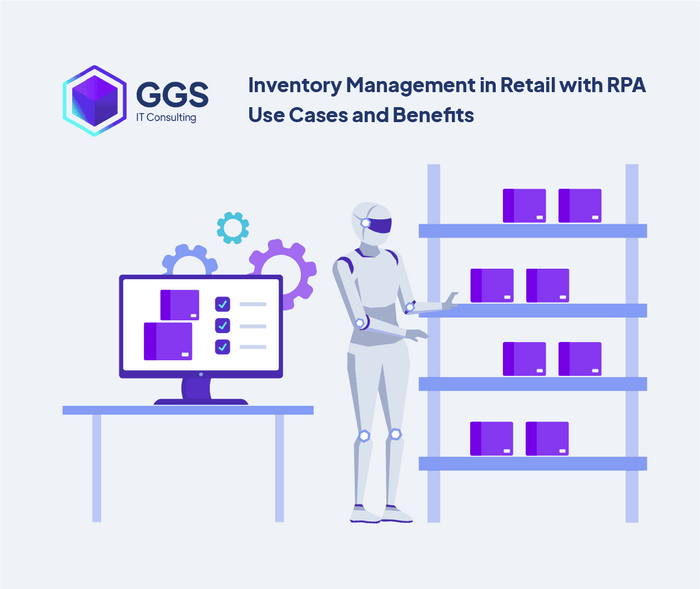
Inventory Management in Retail with RPA, Use Cases and Benefits

Managing inventory in retail is challenging, as it requires gathering and working with data from multiple sources, not only internal but also from suppliers and other business partners. With growing demand and disturbance across supply chains, retailers are struggling to keep track of the amount, location, and pricing of products available for their customers. In this article, we will show examples of how can Robotic Process Automation (RPA) be used to streamline inventory management in the retail industry.
What is Robotic Process Automation (RPA)?

RPA, or Robotic Process Automation, is the name given to software that can perform tasks at the user interface (UI) level. Robots can do anything that employees do and free them from tedious, mundane, and time-consuming tasks. Because RPA is great for repetitive tasks that have to follow a specific set of rules, there are multiple areas of business where these robots thrive. As increasing use is being made of AI, companies utilize robots to automate both front-office and back-office tasks.
Enterprises in multiple industries are benefiting from RPA by accelerating back-end processes. According to Office Worker Survey, conducted by UiPath, 67% of global office workers feel crushed by doing repetitive tasks. They would like to automate many of them, including e-mails, data input, creating datasets, scheduling calls and meetings.
Robots help fill out records and documents and can be used to:
- send automatic notifications,
- make schedule entries,
- transfer data between systems,
- create documents,
- as well as for reporting, controlling or ensuring data compliance.
The implementation of RPA requires preparation. Before replacing human workers with bots, it is essential to analyze the development model and the areas where RPA will optimize costs and working time to deliver the desired business results.
If you want to know more about RPA and its implementation, read our article “What is robotic process automation (RPA)?”.
What is retail inventory management?
Through inventory management retailers ensure that they will have enough products to sell, without risk of running out of stock or carrying excess supply. Effective inventory management allows to keep costs low and understand sales patterns better, effectively supporting also supply forecasting.
Retailers are trying to gather and analyze information related to storing and ordering products, such as:
- exact product locations,
- quantities of each product type,
- sales statistics by location and sales channel,
- profit margins by style, model, product line, or item,
- most accurate amounts of inventory to have in back stock and main storage,
- reorder schedules and amounts,
- seasonal impact on sales.
Without inventory management, it’s impossible to assure that shop will be most profitable. As a manual gathering of data is ineffective, retailers need to use dedicated software to speed up the process. But in many cases buying such additional software is expensive and requires additional programming works to integrate it with systems that the company is already using.
Robotic Process Automation software can be a solution for companies that want to automate inventory management, but struggle to find a tool that would be a perfect fit for their needs.
How RPA can be used for inventory management in retail?

By implementing RPA software, retailers can benefit not only through accurate inventory level tracing but also in demand and supply forecasting, as well as by streamlining communication, related to inventory management, between all departments and suppliers.
With proper process discovery, mapping, and thoughtful implementation of RPA software, it can be really valuable to any retail company. The uses of RPA robots are not limited only to monitoring inventory, generating notifications, or transferring data between systems. It can be also supported by AI and Machine Learning capabilities, to track patterns and help to avoid problems with an inventory shortage.
Some specific use cases of Robotic Process Automation (RPA) software in retail inventory management include:
- tracking and dealing with deadstock,
- avoiding or limiting the risk of stockouts,
- reducing lead times,
- increasing visibility in the supply chain,
- dealing with inventory discrepancies.
How to track and deal with deadstock in retail with RPA?

Deadstock, known also as a dead inventory is a name given to items that retailers have failed to sell and has little likelihood of selling in the future. Those products, if not properly tracked and pushed out of inventory, can pile up and take up space on the shelves or in the warehouse.
Deadstock is a common problem for retailers, its main causes are:
- ordering too many seasonal items that do not sell,
- failing to identify items that are in unpopular sizes, styles, colors, or are out of fashion,
- keeping price too high in the assumption that customers will start buying a product when it should be already discounted and pushed out of inventory.
An example of good use of Robotic Process Automation software in retail to track deadstock can be Walmart. This enterprise has deployed up to date over 500 bots that are used, among others, to track the inventory flow, to identify slow-moving items and deadstock.
RPA can be used to limit deadstock by:
- forecasting demand - so retailers can order items that are most likely to be sold,
- inventory flow tracking - allowing to determine which items are not selling,
- automated alerts - triggered when borderlines are crossed, so employees can be aware and deal with deadstock.
If a retailer has a problem with the same items frequently becoming a deadstock, RPA can be used also to push out such products out of inventory, by automating more processes. Robots can be used not only to notify about the problem but also in the sales process to help with discounting problematic items or bundling them, so retailers can get rid of them faster. As automation with RPA is extremely flexible, developers can set up robots to trigger certain actions when specific conditions are met, and help to get rid of deadstock automatically.
How to reduce stockouts in retail with RPA?
Stockouts called also out-of-stock (OOS) are problematic for retailers as they mean lost sales until the next batch of products arrives. This has a huge impact on customer satisfaction, and while in case of convenient shop location they might return to it in the future, they will most likely not wait for the product to be restocked and will buy it from the competition.
According to Harvard Business School research between 21-43% of customers will buy desired items in another store:

RPA can help to limit stockouts in retail through:
- Accurate data collection - streamlining data transfer between inventory systems, external sources, points of sales, and audits results. Working with correct data allows retailers to deal with problems such as shipment variances, misplaced products, returns, and stolen goods,
- Easy system integrations - with easy and fast data exchange between various tools, including legacy systems, retailers can quickly locate stockouts and reorder them on time,
- Automating notifications and ordering process - RPA can be used not only to collect data, but also to send alerts to employees when items are going out of stock, or even automatically reorder new products (with a proper implementation),
- Tracking stockout patterns - to determine periods when retailers usually experience stockouts they need to analyze vast amounts of data. RPA can be used not only to gather that information but also to compare them accordingly,
- Forecasting - with insights on how certain products were selling in past, retailers can estimate future demand and order items accordingly. With the use of RPA enterprises are able to can compile historical sales data, and other factors such as promotions or seasonality.
It all comes down to being able to capture data on time to use them for supply planning - through the use of RPA, combined with OCR (to digitalize historical, paper documents about sales) and AI for forecasting, retailers are able to determine re-order points and use automation software to proceed with ordering the right merchandise when necessary.
How RPA can reduce lead times in retail?

Lead time in retail is also called a sum of the supply delay - a certain amount of time between ordering merchandise and its arrival in the warehouse. Depending on the complexity of the supply chain lead time can have a major impact on business effectiveness.
For a retailer it would be perfect to be able to rely on local suppliers, allowing them to resupply fast. Unfortunately, most products are not manufactured locally and retailers that work with hundreds or thousands of suppliers across the world have to deal with ordering processes that are far from perfect.
Robotic Process Automation software can help retailers with reducing lead times, and because it does not require any programming to be implemented it can be used quickly and effectively.
RPA use cases may include:
- Speeding up inventory management processes with automated data entry,
- Tracking minimal stock levels and using automated alerts, to place orders before shortage will occur,
- Using RPA for placing automated re-stocking orders, reducing processing time,
- Automating communication between retailers and suppliers,
- Speeding up invoice processing and payments.
With a properly implemented Robotic Process Automation software entire process, from the first automatic alert about low stock level, to place a new order, accepting it on the other end, and fulfillment can be done without a need of human interaction.
Increasing supply chain visibility in retail with RPA

Retailers that are able to track orders throughout the supply chain, from the manufacturer to the distribution center and finally to the store can avoid inventory shortages and bottlenecks and display accurate information about availability.
As for now, many retailers struggle to get a clear picture of their supply chains. According to a study conducted by logistics operator GEODIS and Accenture Interactive, 40% of European brands say that their analytical capabilities related to supply chain visibility are too rudimentary, generating data in a fragmented way, often manually and without clear governance.
RPA can help in solving the most frequently mentioned challenges in supply chain visibility, through:
- Integrating data transfer between supply chain partners without the need for programming,
- Efficient organizing, processing, and managing order data,
- Limiting the number of manual operations and automating order processing,
- Streamlining communication between retailer and supply chain partners,
- Automating data flow for shipping manifests, statuses, invoices, and remittances,
- Generating and sending documents such as Bill of Lading (BoL) and Electronic Proof of Delivery (EPD) for partners and clients.
Robotic Process Automation (RPA) software can help in faster, easier and precise communication between companies. Because data about shipment status can be obtained from partners in real-time, retailers can have a better overview of when and which items will be delivered, so they can coordinate their activities accordingly.
Handling inventory discrepancies in retail with RPA

An inventory discrepancy is a common problem for retailers, and there are various reasons why actual on-hand inventory stock differs from quantities reported by the inventory system. If they are not properly monitored and become undetected, inventory discrepancies result in overstocking and loss in sales.
RPA software can limit discrepancies through:
- Recording correct data during receiving/inbound stock,
- Tracking and recording damaged and returned stock,
- Eliminating human error during stocktake process,
- Forcing the use of correct units of measurement,
- Automatic update of the inventory system.
Scale of discrepancy problem for retailers was best summed up by “Inventory Inaccuracy in Retailing” research, conducted by the ECR Community Shrinkage & On-shelf Availability Group, which reported that “about 60% of the inventory records are likely to be wrong at any point in time, and when they are corrected, a sales growth of 4-8% was noted”.
How we can support RPA implementation in your retail business?

With our experience from working on complex projects, as RPA consultants we are able to guide your company through the entire process of RPA implementation, from creating a strategy, discovering processes, designing optimal configuration, testing, up to full-scale use, and effectiveness monitoring.
GSS IT Consulting experts can support retailers in starting or scaling up digital transformation with RPA through:
- defining strategy,
- analyzing, understanding, and documenting business processes,
- setting up operating models,
- identifying technical infrastructure requirements to deploy automation solutions,
- educating employees and helping to create an “RPA-friendly” environment, where each team member looks for more automation opportunities to support company transformation,
- creating and documenting test scenarios and procedures to ensure optimal configuration,
- training our clients on building, operating, and maintaining automation solutions,
- helping to solve issues that arise in day-to-day operations with RPA software,
- further support of the implementation of any type of automation technologies by the company,
- helping to plan and set up Centers of Excellence or Process Mining Hubs, to boost up automation efforts.
If you are wondering how to improve customer service quality in your e-commerce business with RPA, get in touch with one of our consultants. You can book a free 30 minutes consultation with us and we will help you identify your needs and pick the right technology to match your challenges.
After completing the form, we will arrange a call at a time convenient for you. During the call, our consultant will suggest how to approach the Robotic Process Automation initiative in your Company.
Our recommended articles for RPA implementation in retail:
By providing both basic and in-depth information on digital transformation we are helping our clients at every stage of their journey, ensuring that our Robotic Process Automation consulting services are complete.
You can read more about RPA software and its applications for retailers on our blog:
Top 12 Use Cases of Robotic Process Automation (RPA) in Retail
RPA for Supply Chain Management in Retail, Use Cases and Benefits
